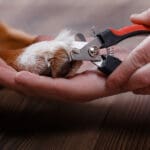“Happy paws = happy pets” — it might sound simple, but the health of your pet’s paws is often overlooked. Let’s dive into everything you need to know about paw care, how “paw-dicures” can make a difference, and how Tipp to Tail supports paw health for pets in daycare, lodging, grooming, and training.
🐾 What Is a Paw-dicure — and Why It Matters
- A paw-dicure (like human manicure + pedicure) is a paw-focused grooming session: trimming nails, smoothing edges, cleaning between toes, addressing mats or hair between paw pads, and hydrating or protecting the pads themselves.
- Why do it? Overgrown nails, cracked pads, trapped debris, or matted paw hair can lead to discomfort, altered gait, infection, or slipping accidents.
- Especially for pets who are in daycare or lodging, or those on slick floors or rough trails, paw health supports both comfort and mobility.
🔍 Common Paw Problems to Watch For
Issue |
Signs to Watch |
Why It Matters |
| Overgrown nails | Nails clicking on floors, snagging carpet, curved inward | Can alter posture or cause pain |
| Cracked or dry pads | Bleeding, flaking, raw patches, licking/chewing | Risk for infection, sensitivity |
| Foreign debris / small cuts | Limping, redness, swelling | Foreign objects can lead to infection |
| Excess fur between pads | Matting, trapping dirt, slipping | Reduces traction, causes irritation |
| Nail splits or chips | Broken edges, exposed quick | Painful and prone to infection |
🧰 Tools & Best Practices for Safe Paw-dicures
Here are what you’ll want in your kit and how to approach it safely:
Paw care tools to have on hand:
- Pet nail clippers or a Dremel tool (grinder)
- Styptic powder (for accidental nicks)
- Nail file (to smooth edges)
- Scissors or small trimmers (for hair between pads)
- Pet-safe paw balm or moisturizer
- Soft cloths or wipes
- Treats & positive reinforcement
Best practices:
- Check the paws first — clean off dirt, inspect for cuts/foreign objects.
- Trim bit by bit — especially in dark nails, the “quick” isn’t visible.
- File the edges — smooth rough spots, so claws don’t catch.
- Trim paw fur — shorter fur around pads prevents debris trapping.
- Moisturize — use pet-safe balms on dry or cracked pads, but don’t over-apply (they’ll lick).
- Go slow & reward — especially for nervous pets, take breaks and reward cooperation.
If you ever see swelling, significant bleeding, or signs of infection, consult your vet or a professional groomer promptly.
🏨 How Tipp to Tail Supports Paw Health
At Tipp to Tail, paw care is one of the many ways we care for your pet’s comfort, safety, and happiness. Here’s how we integrate paw health into our services:
- Grooming & Spa Services: Our grooming team offers full paw-dicure add-ons — nail trims, smoothing, pad moisturizing, and hair trimming between toes.
- Daycare Monitoring: Staff at daycare routinely check paws (especially after outdoor play or inclement weather), wipe off debris, and alert you to any concerns.
- Lodging (Boarding): Overnight pets get a paw check during cleaning rounds. If we see any issues (cracked pads, overgrown nails), we’ll flag it for grooming or vet follow-up.
- Training Sessions: Trainers often work with paws (e.g. during leash handling, agility, obstacle courses). Ensuring nails are short and paws in good health reduces slipping and discomfort.
- Staff Expertise: Our groomers and caregivers are trained to recognize early paw issues — boosting your pet’s comfort before small problems grow.
- Paw Care Tips for You: When you pick up your pet, we’ll often share helpful paw care feedback (e.g. nails needing trim, dryness observed) so you can continue care at home.
🌦 Seasonal Paw Care Tips
Hot pavement in summer
- Avoid midday walks on hot blacktop
- Use pet-safe paw balm or wax before walks
- Wipe paws after walking (sand, salt, grit)
Cold, ice, and salt in winter
- Rinse paws after exposure to salt/ice melt
- Check for ice balls or frozen fur between pads
- Moisturize pads to prevent cracking
Outdoor trails & rough surfaces
- Inspect paws after hikes or rough terrain
- Protect paws from sharp stones or coarse surfaces
✅ At-Home Paw Care Routine (Quick Checklist)
- Inspect paws weekly
- Trim nails every 3–4 weeks (or as needed)
- Clean between toes after walks
- Moisturize dry pads (pet-safe balm)
- Keep fur between pads trimmed
- Watch for behavioral cues (limping, licking, avoiding surfaces)
🐶🐱 Why Paw Health Matters More Than You Think
Pets rely on their paws for nearly every movement — running, jumping, walking, playing. Taking care of paws not only avoids pain but improves balance, reduces joint strain, and helps your pet remain confident and active. A comfortable paw is one less barrier between your pet and enjoying life to the fullest.
🎯 Final Thoughts & Invitation
We believe that caring for your pet’s paws is a vital component of their overall well-being. At Tipp to Tail, we’re not just about pets “staying with us” — we’re about making sure they thrive while they’re here and beyond.
If you’d like to book a paw-dicure add-on, schedule a grooming session, or talk about our daycare / lodging options, reach out. We’d be happy to tailor paw care to your pet’s needs and show you first-hand how we treat every pet like family.






